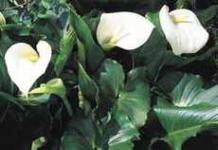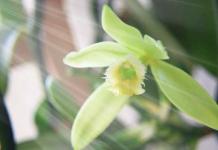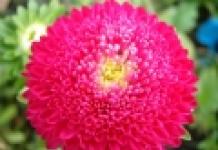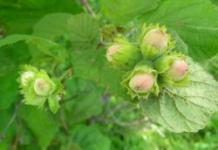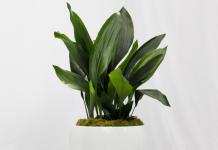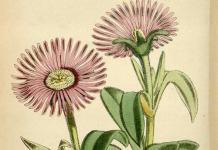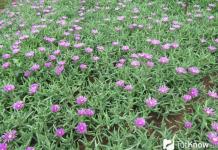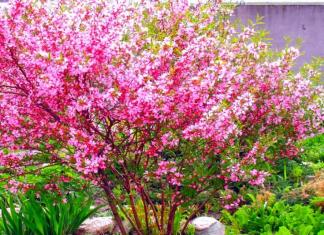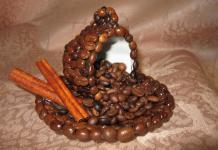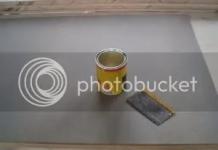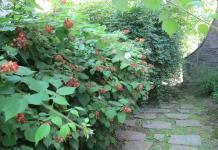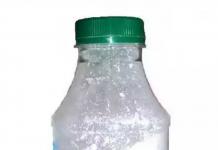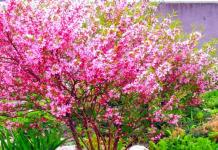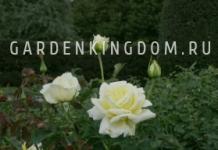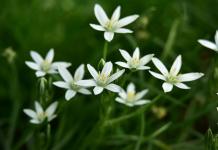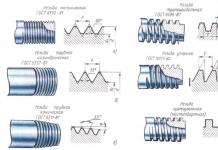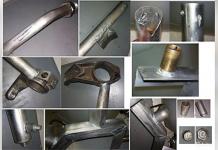Plant propagation methods. The ability to reproduce, as you remember, is one of the main properties of living organisms. Reproduction ensures the growth of the number of organisms and, thus, the maintenance of life on Earth.
Seed plants can reproduce sexually and vegetatively. Sexual reproduction of flowering plants is associated with the formation of germ cells in the stamens and pistils of the flower. So, pollen grains ripen in the anthers, inside which male germ cells - spermatozoa - are formed. The female reproductive cells, the eggs, are produced in the ovules. After pollination and fertilization, a zygote is formed, from which the embryo develops. Due to sexual reproduction, the offspring are somewhat different from the parents. The variability thus arising during sexual reproduction facilitates the adaptation of offspring to various environmental changes.
Vegetative reproduction occurs as a result of the separation of multicellular parts from the mother organism, from which new individuals subsequently develop. It is based on the phenomenon of regeneration. Regeneration (from Latin regeneration - rebirth, restoration) is the ability to restore a whole organism from its part due to cell division and further specialization.
Most flowering plants can reproduce vegetatively. With the help of various vegetative organs or their modifications (for example, tubers, rhizomes, bulbs, mustaches, brood buds).
Vegetative propagation is observed in nature everywhere - in forests, reservoirs, meadows, it can also be seen in household plots. So, perennial grasses (for example, wheatgrass, lily of the valley, mint, sow thistle) propagate by rhizomes. Bulbs - many wild species: snowdrops, lilies, tulips, daffodils. Some plant species reproduce by stem (potato, Jerusalem artichoke) or root (dahlia, chistyak) tubers. Above-ground creeping shoots - mustaches - cinquefoil and strawberries breed. Brood buds, capable of separating from the mother plant and giving rise to a new individual, reproduce sundew, Kalanchoe and others. Many plants reproduce by stem (poplar, alder) or root (cherry, plum, raspberry) offspring that develop from additional buds.
Vegetative propagation is widely used in the cultivation of crops, in gardens, parks. It allows you to quickly increase the number of cultivated plants. Strawberries, potatoes, onions, tulips and many other species are artificially propagated mainly by modifications of the vegetative organs characteristic of them.
Often plants are propagated by cuttings - parts of the vegetative organ (root, shoot) with several buds. Stem cuttings are parts of the shoot with nodes, internodes and buds.
Root cuttings are often used in gardening. They are cut from lateral roots up to 20 cm long, on which additional buds (raspberries, plums) are formed. Some plants (begonia, saintpaulia) are propagated using leafy cuttings. To do this, individual leaves are placed in water or planted in wet sand. Over time, they develop additional buds and roots. In ornamental crop production, the method of dividing bushes is also used (for example, phloxes, primroses, daisies): each bush is divided into parts that have their own roots and shoots, and they are planted in new places.
Graft. Grafting is also widely used in crop production - a special way of artificially combining parts of different plants, that is, the engraftment of a part of the vegetative organ of one plant to another. A plant to which a part of another is grafted is called a rootstock, and a plant that is grafted is called a graft.
Grafting is often carried out in order to enhance certain qualities of the plant. For example, the frost resistance of southern varieties of fruit crops is increased by grafting to the frost-resistant wild form of this plant, or wild game. A wild animal is an individual of a certain type of woody plant that grows in nature or grown from a seed. Thus, it is possible to combine the high palatability of the fruits of the southern scion with the frost resistance of the rootstock. As a result of grafting, the scion and rootstock basically retain their hereditary properties, but they can change in a certain way under the influence of each other. In addition, as a result of such interaction, new useful properties of an artificially created organism may appear.
There are many different methods of vaccination.
Budding is the grafting of a scion, which is a kidney with a thin layer of wood (the so-called eye). A T-shaped incision is made on the rootstock, where the eye is inserted. The edges of the bark are rolled up, pressed against the scion, coated with garden pitch and tied.
The method of grafting, in which a scion cut obliquely is combined with a stock cut in the same way, is called copulation. It is used when the scion and stock are of the same thickness. Oblique cuts allow you to increase the surface of their contact, which accelerates the process of fusion.
If the stock is much thicker than the scion, cleft grafting is used. At the same time, the stock is split and a scion cutting is inserted into the gap formed, the end of which is cut off in the form of a wedge. The place of vaccination is covered with garden pitch and tied.
Grafting under the bark is carried out in the spring, when the activity of the cambium increases in plants. The bark at this time is easy to separate from the wood. A horizontal cut is made on the rootstock. Then the bark is cut in a vertical direction down from the cut and its edge is carefully bent. As a scion, a cutting with 2-4 internodes is taken. A cone-shaped cut is made from the lower end and the scion is inserted under the rootstock bark so that its convex side is directed outward. At the same time, the bent ends of the bark are well pressed and the place of inoculation is tied.
The faster the scion and rootstock grow together, the better the grafting results. If the tissues of the scion and rootstock are the same, especially the cambium of the vascular bundles, the fusion occurs very quickly and the grafting is successful.
The biological significance of vegetative propagation. As a result of vegetative reproduction, daughter individuals are formed from the mother's organism, similar to it in hereditary characteristics. This ensures the rapid growth of the species and its dispersal, which is especially important for species with a short life span and in cases where sexual reproduction is impossible (for example, if certain individuals grow separately from other plants of their species).
Vegetative propagation of cultivated plants is of great practical importance.
Firstly, thanks to him, a person can receive a significant amount of planting material (remember, for example, how many tubers can form in one potato plant).
Secondly, due to vegetative reproduction, the hereditary properties of the mother individual are preserved in the offspring, that is, they are its copy. As you already know, as a result of cross-pollination, the descendants receive part of the hereditary material from one of the parent individuals, and part from the other. Therefore, in their hereditary properties, they are somewhat different from the original forms.
The main and most complete way to replenish the collection is seed propagation. According to the existing definition, a seed is a fertilized mature ovule that has an embryo, reserve nutrients and a protective shell. The germinal root, hypocotyl or hypocotyl knee (part of the stem), the embryonic bud and cotyledons, the number of which in cacti is usually equal to two, are isolated from the seed embryo. The rest of the seed is filled with a nutrient called endosperm. On the shell, one can distinguish a scar - the place of attachment of the seed and a micropyle - a narrow channel through which the pollen tube penetrates and fertilization occurs. When seeds germinate, the root elongates and penetrates into the soil. At the beginning of germination, all the cells of the embryo divide, but after the formation of the seedling, cell division is localized at the tips of the shoot and root.
The lifespan of plant seeds, including cacti, varies greatly. It is known, for example, that the seeds of lupine from the Arctic tundra, having lain in frozen silt for about 10 thousand years, germinated well. Cactus seeds have different lifespans. The seeds of rebutia, ailoster and some other genera have a short life. Their germination period is limited to approximately one year. Conversely, in members of the genus Cereus and Mamillaria the life of seeds can reach 7 - 9 years. More long-lived seeds are also known.
In addition to biological reasons, the lifespan of seeds depends on the conditions of their storage. There are two independent storage rules: 1) with an increase in water in the seeds by 1% (with an optimum of 5 - 14%), their life span is reduced by 2 times, while below the optimum, fat oxidation occurs, and above - damage by fungi; 2) with an increase in temperature for every 5° (in the range of 0 - 50°), the life of the seeds is also reduced by 2 times. In other words, so that the seeds do not lose their germination, it is desirable to store them in the optimal range of temperatures and humidity, if possible without changing these parameters.
For seed germination, certain conditions must be created. Among the most important factors for germination are water, temperature and, to a lesser extent, light. To come out of dormancy, seeds must absorb a certain amount of water. At the same time, the physiological processes that ensure germination are resumed. Lack of moisture inhibits seed germination and reduces germination. A growing seedling needs much more water than a seed to germinate.
The temperature range of seed germination is usually quite wide, but rapid germination requires a certain optimum, which can vary even in different plants of the same species. Empirically, it was found, for example, that the seeds of cleistocactus, unlike most other types of cacti, have the best germination at a temperature of only 11 °. Most seeds can germinate well at a constant temperature, but diurnal fluctuations are still desirable, as occurs in nature.
It is believed that the seeds of most plant species do not need light to germinate, and only a few species require some light. For photosensitive species, a certain photoperiod is required, that is, a change of day and night. It has also been found that the seeds of many plant species are sensitive to light of a certain wavelength. Thus, illumination of seeds with red light of different wavelengths stimulated their germination.
The simplest and most reliable way to remove cactus seeds from dormancy is to soak them in a weak solution of potassium permanganate for one day at room temperature. To do this, the seeds are poured into bags of loose, well-permeable paper and immersed in a solution. Appropriate inscriptions on the bags can be done with a simple pencil or ballpoint pen.
The most suitable time for sowing seeds is spring. March crops make it possible to grow by the end of the year quite large viable plants that easily tolerate wintering. Seed germination time is not the same for different types of cacti. Usually most seeds germinate within a week. It depends on the quality of the seeds and how deep their dormancy was. During long-term sowings, the record holder for germination rate was one of the types of large-flowered neochilling. Soaked seeds germinated after about 12 hours.
There are two types of asexual reproduction: vegetative and actually asexual. In some lower plants, there is no clear boundary between these types of reproduction.
The most common form of asexual reproduction is vegetative reproduction. During vegetative propagation, a relatively large, usually differentiated part is separated from the plant, which develops into an independent plant. It is carried out by parts of the thallus, root, stem, leaf. It is based on the ability of plants to regenerate - to restore the whole organism from its part. At unicellular plants (algae, bacteria) vegetative reproduction occurs by cell division, in colonial and lower multicellular organisms - by dividing the thallus into parts, in fungi - with the help of specialized unicellular formations: chlamydospores, etc. higher plants vegetative propagation is carried out by parts of the root, stem, leaf or their modifications - rhizomes, tubers, bulbs, brood buds. On the basis of natural vegetative propagation in the practice of agriculture, various methods of artificial vegetative propagation of vegetable, fruit and ornamental plants have been developed. For this, the most commonly used are: clubs (potatoes, sweet potatoes, dahlias), rhizomes (iris, phlox), mustaches (strawberries), bulbs (onions, tulips), root suckers (raspberries, cherries). Many cultivated plants are propagated by cuttings, layering, and also by grafting.
Reproduction by cuttings. A stalk is a section of a shoot, root, or leaf cut off from the mother plant. Shooting cuttings can be winter - without leaves (but with buds), and summer - with leaves with the shoot of the current year. The leaf stalk consists of a leaf blade and a petiole. Adventitious roots appear more often on the morphologically lower side of the leaf in places where large veins branch, buds, and then shoots - on the upper side. Only a few plants (lily, begonia, aloe, etc.) can be propagated by leaf cuttings. Root cuttings propagate plant species whose roots easily form adnexal buds (raspberries, cherries, plums, date palms, roses, phlox, etc.).
Reproduction by grafting. Graft- this is the fusion of cut buds or stem cuttings of one plant (propagated) with another (rooted). In this case, the propagated plant is called a scion, and the plant to which it is grafted is called a rootstock. About 100 different methods of vaccination are known, but they can be reduced to three main types: rapprochement, or ablactation, - the graft is not separated from the mother plant until it grows together with the stock; graft cutting, or copulation, - on annual cuttings of the scion with 2-3 buds and on the stem of the stock, oblique cuts are made and applied to each other, while the stems of the scion and stock are selected of the same thickness so that their cambial layers coincide. If the diameters of the scion and rootstock do not match, then grafting is done split, under the bark, butt or in other ways; eye grafting, or budding, - a dormant or growing bud, separated from the middle part of the shoot of a propagated plant, which is inserted under the rootstock bark, serves as a graft. Intergrowth occurs best if the scion and rootstock belong to the same species or close species of the same genus, but if they belong to different genera, intergrowth is difficult.
Strictly asexual reproduction Carried out by specialized cells spores or zoospores. Spores have a hard wall and are spread by the wind, zoospores do not have a hard wall and move with the help of flagella. They are formed inside the organs of asexual reproduction - sporangia or zoosporangia. In lower plants it is a unicellular organ, in higher plants it is multicellular. The variety of disputes is great. By origin and purpose, spores are divided into two groups: spores (zoospores), which are formed by mitotic division and capable of directly reproducing a new individual similar to the mother. When mature, they leave the mother's body and usually serve for reproduction and distribution. Reproduction by such spores is characteristic of lower
plants (algae, fungi, etc.). The second group includes spores that cannot reproduce from the mother. They are haploid (n) as they are formed as a result of meiosis. Such spores occur in higher plants, as well as in some algae. In the latter, a growth (prothallium, protonema) first grows from the spore, on which sexual reproduction occurs.
essence sexual reproduction or reproduction consists in the formation of specialized cells by the plant - gametes (n), in their pairwise fusion (copulation) and the formation of a zygote (2n), from which a new plant grows.
A gamete is an ego sex cell, the nucleus of which contains a haploid number of chromosomes. Copulating gametes can differ among themselves in structure (shape, size, mobility), but necessarily physiologically, that is, by sex and heredity. As a result of the fusion of gametes in the new organism, maternal and paternal heredity are combined. If copulating gametes are the same in shape, size and mobility, they are called isogametes, and the sexual process - isogamous. If the gametes are the same in shape, but the female gamete is larger and less mobile than the male, they are called heterogametes, and the sexual process - heterogamous. The sexual process is called oogamous when the female gamete is large, spherical, immobile (ovum), and the male gamete is very small and mobile (spermatozoon).
The specialization of gametes serves as an indicator of the level of evolution. The most primitive form of the sexual process is isogamy. Gametes are formed in special organs called gametahygia: male - in aitheridia, female - in lower plants in oogonia, and in higher plants - in archegonia. In lower plants, gametangia, like sporangia, are unicellular, while in higher plants they are multicellular. Some groups of algae and fungi do not have organs of sexual reproduction, although the sexual process is carried out regularly. Their zygote is formed as a result of the fusion of unspecialized cells or segments. This sexual process is called somatogamy. A variation of somagogamy is hologamy, when two single-celled vegetative individuals merge without the formation of gametes.
Fertilization- this is the process of fusion of two germ cells - male and female gametes. The male gamete in angiosperms is called the sperm, the female is called the egg. One of the pollen cells that has fallen on the stigma of the pistil is pulled out through the pore of the exine into a long pollen tube, sometimes reaching several centimeters. In it, due to the division of the generative cell, two sperm are formed. The pollen tube grows through the loose tissue of the stigma and style in the direction of the ovary of the pistil, enters the ovule through the micropyle or through the integument, and comes into contact with one of the synergids. The pollen tube then penetrates the synergida and bursts, releasing the sperm. One of them fuses with the egg, forming a zygote (2n), the second fuses with the central cell of the embryo sac, forming a triploid cell (3n). This is how it goes double fertilization, which is unique to angiosperms. The discovery of double fertilization belongs to the Russian scientist Academician S.G. Navashin (1898). After double fertilization, an embryo (2n) is formed from the zygote: from the triploid cell - endosperm (storage tissue, Sn), from integuments - spermoderm (seed peel), and from the entire ovule - seed. Synergids and antipodes are usually destroyed, and the nucellus is used as a nutrient product during the formation of the embryo, less often it turns into a storage tissue - perisperm.
After fertilization, the ovule is called a seed, and the ovary is called a fruit.
The zygote grows by repeated mitotic divisions and turns into a multicellular embryo, consisting of a primary shoot, or plumule, a primary root, and one (in monocotyledonous) or two (in dicotyledonous) cotyledons. The cotyledons have a simpler structure than the first true leaves; sometimes they are filled with nutrients and serve as storage tissue, as, for example, in peas and fava beans. Plumula consists of a stem, the first pair of true leaves and a terminal bud. The triploid nucleus of the primary endosperm divides many times by mitosis, forming endosperm - an accumulation of triploid nuclei separated from each other by thin cell walls. In some cereals, such as wheat and corn, the endosperm retains the role of a storage tissue. If the cotyledons serve as a storage tissue, they grow at the expense of the endosperm, which may completely disappear in this case. In some seeds, nutrient reserves are contained in both the endosperm and the cotyledons. As the growth of the embryo and storage tissue continues, the surrounding nucellus is destroyed, supplying the nutrients necessary for growth. In the future, the nutrients necessary for growth are provided by the conducting bundle of the stalk of the ovule (funiculus). The testa (seed coat) develops from the integument. Ego is a thin but strong protective layer. The micropyle is preserved as a small pore in the dough, through which oxygen and water enter during seed germination. At the final stages of seed maturation, the water content in it decreases from about 90% (by weight) common for plant tissues to 10-15%. This is accompanied by a marked decrease in metabolic activity and represents an important step towards the transition of the seed into a dormant state. As the seed develops, the ovary turns into a mature fruit, and its walls are called the pericarp. The changes that take place in different plant species are different, but usually these changes are aimed at ensuring that the fruit can protect the seeds and help them spread. The remaining parts of the flower wither, die off and are shed, like the leaves of deciduous trees.
Advantages and disadvantages of propagation by seeds. Advantages
1. The plant does not need an aquatic environment for sexual reproduction, and. hence better adapted to life on land.
2. The seed shuts up the germ.
3. The seed contains the nutrients needed by the embryo; these substances are contained either in the cotyledons or in the endosperm.
4. The seed usually has the means to propagate.
5. The seed can go dormant to survive adverse conditions.
6. The seed reacts to favorable conditions, but sometimes it does not germinate immediately.
Flaws
1. Seeds are relatively large due to their significant nutrient reserves. This makes seed dispersal more difficult than spores.
2. Nutrient reserves make seeds an attractive food for animals.
3. Pollination is largely carried out by external factors such as wind, insects and water. Therefore, pollination (and hence fertilization) is largely a matter of chance, especially wind pollination.
4. Seed losses are very high due to the limited chances of survival of each given seed. Therefore, to ensure success, parent plants have to invest large amounts of substances and energy in seed production.
5. The food resources of the seed are limited, while in vegetative propagation, the daughter plant receives nutrients from the parent plant until it reaches independence.
6. Two individuals are involved in the reproduction of dioecious plants, which makes it more dependent on chance than reproduction in which one parent individual participates. It should be noted, however, that dioecious plants are quite rare.
Woody plants reproduce in two ways - seed and vegetative. Seed propagation in nurseries is carried out by sowing seeds and growing seedlings from them. Vegetative propagation is carried out by parts of the plant of the original form - cuttings, layering, root offspring and grafting. Many species of poplar, willow, currant, tamariks, grapes and other shrubs, as well as garden forms of tree species (spherical, pyramidal, weeping, variegated) and seedlings of fruit crops are propagated vegetatively in the nursery.
The widespread use of the seed propagation method in nurseries is explained, firstly, by its simplicity, high productivity and, hence, great profitability, and secondly, by the fact that woody plants obtained by this method are distinguished by a powerful root system, better technical qualities of wood, greater vitality, and hence greater durability.
Fruiting and collecting seeds.
As soon as a woody plant of one species or another reaches the age of physiological maturity, it begins to systematically bear fruit. Physiological maturity in different breeds occurs at different times, which depends on a number of internal (biological) and external causes. Thus, most fast-growing breeds begin to bear fruit at an earlier age than slow-growing breeds. For example, ash-leaved maple begins to regularly produce seeds from the age of 7, white acacia - from 5-6, and common oak - not earlier than from 12-15 years. Trees in natural conditions come into fruiting at an average of 20-25 years, shrubs - at 4-5 years.
The timing of fruiting age depends on the soil and climatic conditions and especially the location of the woody plant in the plantation and the associated degree of illumination. For example, pine in natural full plantations begins to bear fruit at 40-50 years, while in artificial plantations in the southern steppe conditions - from 8-10 years. Oak in natural plantations begins to systematically bear fruit from the age of 35-40, and in artificial plantations in the southern steppe regions - from 20 and even from 15 years. Birch in natural massifs bears fruit from 25 - 30 years, and in artificial steppe plantings - from 10 years.
In the fruiting of tree species, there is an important biological feature - this is the so-called periodicity of fruiting, which is characteristic of most of the most important forest tree species. It lies in the fact that large seed yields in these breeds are repeated not every year, but after certain periods. Years of abundant seed harvests - seed years are usually replaced by lean years, when there are very few or no seeds at all. In the intervals between lean and seed years, there are years of average harvests.
As long-term observations have shown, seed years for different tree species are repeated as follows:
annually- in white acacia, birch, horse chestnut, ash-leaved maple, sycamore maple, poplars, green ash, elm, common cherry, in most shrubs;
after 1 - 2 years- in hornbeam, field maple, silver maple, honey locust, linden, nuts, apricot, white mulberry, cherry plum, common ash, arborvitae, juniper, honeysuckle, sucker, sweet cherry, sea buckthorn, skumpia, mountain ash, apple tree, pear;
after 3 - 4 years- in Norway maple, fir, pine, spruce, hazel;
after 5 - 7 years- in oak, larch, beech.
The frequency of fruiting, besides the most important - for forestry and green building tree species (oak, beech, maple, common ash, pine, spruce, etc.) should be considered as a negative phenomenon from an economic point of view. The periodicity of fruiting always keeps under threat the planned production of planting material or the creation of green forest and forest plantations by sowing seeds directly to a permanent place.
4. Factors affecting seed production.
The frequency of fruiting and, in general, the fruiting of tree species is affected by:
1. Climatic conditions and especially air temperature: where the climate is warmer, seed years are repeated more often and seed quality is higher. For example, seed years in Scots pine in Ukraine occur after 3-4 years, in the northern regions of Russia with a harsh climate (Kola Peninsula) - after 10-15 years, and in Western Europe with a mild climate - after 2-3 years. Common oak (summer) in the central regions of Russia bears abundant fruit in 5-7 years, and in Western Europe with a warm climate - almost annually.
2. Soil conditions: where they are favorable, abundant seed crops are repeated more often.
3. The degree of illumination: the more light the trees receive, the more abundantly they bear fruit. The illumination of a tree is determined by its position in the forest, in general in the plantation. In the best lighting conditions are trees growing on the edges of the forest, in the woodlands and especially free-growing trees (seed plants in cutting areas, tapeworms in clearings). They bear fruit profusely and almost every year.
On the contrary, trees growing in full stands, where the lighting conditions for most of them (except the tallest ones) are unfavorable, are characterized by weak fruiting with a rare repetition of seed years.
4. Meteorological conditions, especially during flowering of woody plants and seed maturation. So, spring frosts during flowering damage the flowers and the resulting ovary, resulting in reduced seed yield. Very rainy weather during flowering ruins the crop to a greater or lesser extent, as it interferes with the normal pollination of flowers. Dry and very hot summers are also unfavorable for the harvest, since normally set fruits are underdeveloped, “burn out” and fall off prematurely.
5. Pests and diseases of the forest, which, when widespread, often completely destroy the crop. These are, for example, oak and apple codling moths, oak weevil, fruit rot, etc.
Knowing the reasons for the periodic fruiting of tree species, it is possible to achieve more frequent and abundant seed yields by eliminating unfavorable and creating more favorable environmental conditions surrounding mother plantations. By severely thinning out dense or so-called dense stands, thinning out the crowns of individual trees, thereby ensuring maximum access of light to mother plants, improving their nutritional conditions by applying organic and mineral fertilizers, it is possible to achieve annual good yields of seeds of most tree species.
These measures to combat the periodicity in the fruiting of tree species formed the basis for the organization of seed plots in forestry as a basis for obtaining high quality seed.
Harvest accounting.
Harvest accounting is the determination of the actual presence of cones, fruits, seeds. To account for the harvest, various methods are used that allow, without collecting cones, fruits, seeds, to determine their number. Harvest accounting allows you to competently plan your activities in relation to the harvesting of cones, fruits, seeds and understand how much crop you can harvest and whether you need to buy the missing seeds on the side. Yield accounting is carried out in the third phase of the development of cones, fruits, seeds, when they are clearly distinguishable. Harvest accounting is carried out in dry weather.
All woody plants reproduce in two ways - seed and vegetative. seed propagation carried out by sowing seeds in the nursery and growing seedlings from them. This method is characterized by simplicity, high productivity, and great economy. Woody plants obtained in this way have a powerful root system, are viable and durable.
Vegetative reproduction produced by parts of the plant - cuttings, layering, root offspring and grafting. Poplars, willows, currants, tamarix, grapes and other plants, as well as spherical, pyramidal, weeping variegated forms of tree species and seedlings of tree crops are propagated in this way in the nursery.
 Trees and shrubs begin to systematically bear fruit upon reaching adulthood. Fast-growing breeds bear fruit at an earlier age than slow-growing ones. So, the fruiting of acacia begins from 5-6 years, and the common oak - from 12-14 years. Trees in natural plantations begin to bear fruit at a later age than in artificial ones. So, pine in natural plantations begins to bear fruit at the age of 40-50, in artificial - from 10 years; oak in natural plantations bears fruit from 35-40 years old, and in artificial (in the south) - from 20 years old.
Trees and shrubs begin to systematically bear fruit upon reaching adulthood. Fast-growing breeds bear fruit at an earlier age than slow-growing ones. So, the fruiting of acacia begins from 5-6 years, and the common oak - from 12-14 years. Trees in natural plantations begin to bear fruit at a later age than in artificial ones. So, pine in natural plantations begins to bear fruit at the age of 40-50, in artificial - from 10 years; oak in natural plantations bears fruit from 35-40 years old, and in artificial (in the south) - from 20 years old.
All trees and shrubs do not bear fruit annually, but after certain periods. Seed harvesting usually begins with the collection of fruits. The fruits of tree species are divided into two groups: dry and juicy. Dry fruits are fruits with a uniform-skinned or woody pericarp. They, in turn, are divided into non-opening and drop-down. Non-opening nuts include a nut - a fruit with a hard, lignified pericarp, for example, oak acorn, hazel, beech nut, hazelnut; a nutlet (like an achene) - in birch, alder, linden, hornbeam. Achenes are lionfish fruits of ash, maple, elm, under the influence of the wind they spread over long distances. The opening fruits are pods and beans. The first includes boxes of willow, poplar, aspen, lilac, chestnut, spindle tree, the second - beans of yellow and white acacia, honey locust.
 There are other types of fruits as well. So, a drupe is a juicy, one-seeded fruit of cherry, plum, dogwood, bird cherry, blackthorn, viburnum, sucker, bean, pride, almond, pistachio, walnut and black; berry - juicy multi-seeded fruit of currant, gooseberry, privet, honeysuckle, Amur velvet, sea buckthorn, grapes, etc. Seed - part of the fruit that developed from the ovary ovary, the reproductive organ of all seed plants. In practice, the fruits themselves are sometimes also called seeds, especially when the seeds are difficult to separate, for example, lionfish of maples, ash trees, etc.
There are other types of fruits as well. So, a drupe is a juicy, one-seeded fruit of cherry, plum, dogwood, bird cherry, blackthorn, viburnum, sucker, bean, pride, almond, pistachio, walnut and black; berry - juicy multi-seeded fruit of currant, gooseberry, privet, honeysuckle, Amur velvet, sea buckthorn, grapes, etc. Seed - part of the fruit that developed from the ovary ovary, the reproductive organ of all seed plants. In practice, the fruits themselves are sometimes also called seeds, especially when the seeds are difficult to separate, for example, lionfish of maples, ash trees, etc.
Good seed material can only be obtained from ripe and timely harvested seeds. As the fruit ripens, the color of the fruit changes from green in immature fruits to dark brown, brown, red, black in mature ones. Some seeds immediately crumble after ripening (birch, poplar, fir, elm), others remain on trees for a long time, often until the next spring (white locust, ash-leaved maple, linden, etc.). Seeds damaged by various fungal diseases or pests are not subject to collection. The collection is made from growing trees before the seeds fall or from the ground after they fall from the trees.
 Seeds from cones are extracted in dryers at a certain temperature. The maximum temperature in the drying chambers for pine is 50°C, and for spruce and larch 40-45°C. Drying chambers must be equipped with permanent ventilation to quickly remove the moisture evaporating from the cones.
Seeds from cones are extracted in dryers at a certain temperature. The maximum temperature in the drying chambers for pine is 50°C, and for spruce and larch 40-45°C. Drying chambers must be equipped with permanent ventilation to quickly remove the moisture evaporating from the cones.
Seeds of common elm, elm, birch bark begin to be collected from the moment the lionfish turn yellow 3-5 days before their massive fall, then they are cleaned of impurities and dried for 4-5 days in a protected place. Lionfish are collected in calm weather (teared off or shaken off) on a specially laid canopy. The collected lionfish are immediately sown.
Large seeds of oak, beech, walnut, horse chestnut, fruits of apple, pear, apricot, etc. are usually collected from the ground. Apple and pear seeds are obtained from fruits by crushing them in special crushers or by hand - the fruits are poured into a barrel, crushed with a wooden pestle, and then washed in sieves.
 Juicy fruits of cherries, plums, apricots, cherry plums, honeysuckle, currants, mulberries, etc. are poured into a barrel, some water is poured into it and kneaded with hands or wooden pestles. Then water is poured five to six times more than the volume of the crumpled mass, mixed and the pulp that has floated to the top is removed. After two or three such operations, clean seeds remain at the bottom, which are then dried for several days in rooms in the attics. Juicy fruits in a day or two must be processed immediately, as in heaps they self-heat, ferment and lose their germination. From the beans of acacia white and honey locust, seeds are extracted by drying the fruits and threshing them with sticks, chains and threshers, after which they are cleaned on sieves and on a fan.
Juicy fruits of cherries, plums, apricots, cherry plums, honeysuckle, currants, mulberries, etc. are poured into a barrel, some water is poured into it and kneaded with hands or wooden pestles. Then water is poured five to six times more than the volume of the crumpled mass, mixed and the pulp that has floated to the top is removed. After two or three such operations, clean seeds remain at the bottom, which are then dried for several days in rooms in the attics. Juicy fruits in a day or two must be processed immediately, as in heaps they self-heat, ferment and lose their germination. From the beans of acacia white and honey locust, seeds are extracted by drying the fruits and threshing them with sticks, chains and threshers, after which they are cleaned on sieves and on a fan.
Storage and preparation of seeds for sowing. The period from the moment of sowing to their mass emergence is called seed dormancy. Seeds are with short seed dormancy, fast-germinating, they do not require special preparation for sowing (birch, oak, elm, spruce, Scotch pine, white and yellow acacia, mulberry, etc.). Seeds with long seed dormancy, slowly germinating, require preliminary preparation to accelerate the germination period. These include seeds of hornbeam, linden, common ash, euonymus, wild rose, maple, most stone fruit, pome fruits (apple, pear, etc.).
 Stratification- this is a method of preparing seeds for sowing, ensuring the germination of seeds that have a long family dormancy. Seeds are subjected to stratification, which, without prior preparation, do not germinate in the same year. The essence of stratification is to create the conditions necessary for the passage of the initial stage of seed germination. It is carried out in special rooms, in warm, cold and summer trenches or under snow. The optimal stratification temperature for most seeds is +4-6°C with allowable fluctuations from 0 to + 10°C. The duration of stratification, depending on the breed, ranges from one to eight months.
Stratification- this is a method of preparing seeds for sowing, ensuring the germination of seeds that have a long family dormancy. Seeds are subjected to stratification, which, without prior preparation, do not germinate in the same year. The essence of stratification is to create the conditions necessary for the passage of the initial stage of seed germination. It is carried out in special rooms, in warm, cold and summer trenches or under snow. The optimal stratification temperature for most seeds is +4-6°C with allowable fluctuations from 0 to + 10°C. The duration of stratification, depending on the breed, ranges from one to eight months.
 The best environment for seed stratification is peat chips (dry peat sifted through a sieve with 5 mm cells) and clean river or well-washed mainland sand (particle size 0.5-1 mm). For stratification, the seeds are well mixed with a triple volume of peat chips or sand (for one part of the seeds, 3 parts of peat or sand). A mixture of seeds with peat or sand is moistened to a moderately wet state. The required moisture content of the sand (50-60% of the total moisture capacity) is achieved by adding water to it at the rate of 0.15 l/kg. With such humidity, sand, when compressed in the hand, does not emit water, but it does not crumble, it retains its shape. The required moisture content of the peat crumb is checked in the same way. If, during its compression, water comes out slowly - in rare drops, the humidity of the peat crumb is considered normal.
The best environment for seed stratification is peat chips (dry peat sifted through a sieve with 5 mm cells) and clean river or well-washed mainland sand (particle size 0.5-1 mm). For stratification, the seeds are well mixed with a triple volume of peat chips or sand (for one part of the seeds, 3 parts of peat or sand). A mixture of seeds with peat or sand is moistened to a moderately wet state. The required moisture content of the sand (50-60% of the total moisture capacity) is achieved by adding water to it at the rate of 0.15 l/kg. With such humidity, sand, when compressed in the hand, does not emit water, but it does not crumble, it retains its shape. The required moisture content of the peat crumb is checked in the same way. If, during its compression, water comes out slowly - in rare drops, the humidity of the peat crumb is considered normal.
 Stratification is carried out in wooden boxes installed on racks in rooms specially allocated for this purpose. Seeds mixed with sand or peat are poured into boxes 0.3 m high, 0.4 m wide, 0.6-0.7 m long with holes 0.5 cm in diameter in the bottom to drain excess water and in the side walls - for aeration. From above, boxes for protection against rodents are covered with metal nets and placed in basements on the floor or racks.
Stratification is carried out in wooden boxes installed on racks in rooms specially allocated for this purpose. Seeds mixed with sand or peat are poured into boxes 0.3 m high, 0.4 m wide, 0.6-0.7 m long with holes 0.5 cm in diameter in the bottom to drain excess water and in the side walls - for aeration. From above, boxes for protection against rodents are covered with metal nets and placed in basements on the floor or racks.
To speed up stratification, seeds collected last year are pre-soaked for 3-5 or more days, depending on the structural features of their outer covers. Water is changed daily. The seeds of linden, skumpia, dogwood, dog rose, which have a harder cover, are usually soaked for 10 days. Seeds should swell well, which is determined by cutting them open. During stratification, the mixture of sand and seeds is periodically (at least once every 15 days) poured out of the boxes, mixed thoroughly and moistened, if necessary, to the initial moisture content.
 Lowering the temperature in the room is allowed to -4 ° C, but not more than 2-3 days. In those cases when the seeds begin to germinate ahead of time, the boxes are taken out of the storage to a shady place, where they are buried in the snow so that the thickness of the snow layer above the boxes is at least 1 m, or (if there is no snow) they are placed on a glacier. From above, so that the snow does not melt, it is covered with straw or manure. You can put the boxes in the cold store and store them there until spring sowing. In the spring, a day or two before sowing, the seeds are separated from sand or peat, sieved through a sieve (with holes so that the seeds do not pass through them), and then immediately sown so that they do not dry out.
Lowering the temperature in the room is allowed to -4 ° C, but not more than 2-3 days. In those cases when the seeds begin to germinate ahead of time, the boxes are taken out of the storage to a shady place, where they are buried in the snow so that the thickness of the snow layer above the boxes is at least 1 m, or (if there is no snow) they are placed on a glacier. From above, so that the snow does not melt, it is covered with straw or manure. You can put the boxes in the cold store and store them there until spring sowing. In the spring, a day or two before sowing, the seeds are separated from sand or peat, sieved through a sieve (with holes so that the seeds do not pass through them), and then immediately sown so that they do not dry out.
There are a number of other ways to prepare seeds for rapid germination. Scarification- this is a violation of the integrity of the seed coat by mechanical means. It is produced by grinding seeds with coarse sand between sandpaper. After scarification, the seeds are soaked in water for 12 hours and sown in moist soil.
 Seeds of white acacia, honey locust, tree-like vesicle, Japanese Sophora, etc. are treated with scalding. This operation is performed as follows. Seeds are poured into a bucket or barrel, filled with water, the temperature of which is 80-90 ° C, stirred for 10-15 minutes and left to swell for a day. Then the water is drained, and the seeds are aired on a tarpaulin to a state of flowability, after which they are immediately sown.
Seeds of white acacia, honey locust, tree-like vesicle, Japanese Sophora, etc. are treated with scalding. This operation is performed as follows. Seeds are poured into a bucket or barrel, filled with water, the temperature of which is 80-90 ° C, stirred for 10-15 minutes and left to swell for a day. Then the water is drained, and the seeds are aired on a tarpaulin to a state of flowability, after which they are immediately sown.
Before spring sowing, seeds are often soaked to soften the shell and swell the embryo. Thus, the soaking of seeds of pine and spruce is carried out for 12 hours, larch - 12-24 hours, elm, elm, birch bark - 3-4 hours, white mulberry, sea buckthorn, birch - 2-3 days, green ash - 2-3 days , walnut, chestnut, plane tree (in warm water) -3-5 days. When soaking for more than a day, the water is changed daily. The temperature in the room should not be lower than 18-20°C. Seeds are poured 2/3 into bags of rare fabric and immersed in barrels of water at room temperature. Good results are obtained by soaking coniferous seeds in a 0.25% solution of potassium permanganate (potassium permanganate), while 2.5 g of the substance is dissolved in 1 liter of water for 30 minutes.
 The use of growth stimulants. Pre-sowing treatment of seeds with aqueous solutions of microelements increases their germination energy, and, consequently, seed germination. The most effective in this regard are trace elements:
The use of growth stimulants. Pre-sowing treatment of seeds with aqueous solutions of microelements increases their germination energy, and, consequently, seed germination. The most effective in this regard are trace elements:
for pine - 0.02% solution of zinc sulfate, 0.05% solution of cobalt sulfate, 0.002% solution of potassium permanganate, 0.03% solution of copper sulfate and a mixture (solution of potassium permanganate, boric acid, copper sulphate, zinc sulphate and cobalt sulphate, 0.002% each); for larch - 0.029% solution of zinc sulfate, 0.03% solution of cobalt sulfate and 0.1% solution of sodium bicarbonate; for spruce - 0.03% solution of cobalt sulfate, 0.03% solution of copper sulfate and a mixture (solution of potassium permanganate, boric acid, copper sulfate, zinc sulfate and cobalt sulfate, 0.002% each).
 In microelement solutions, the seeds should be soaked for 10-12 hours, and then air-dried in the shade, after which they should be sown immediately. For 1 kg of seeds, 2 liters of solution are consumed.
In microelement solutions, the seeds should be soaked for 10-12 hours, and then air-dried in the shade, after which they should be sown immediately. For 1 kg of seeds, 2 liters of solution are consumed.
Seed dressing. To prevent damage to seeds by fungi and bacteria, which, settling on their surface, interfere with germination and cause seedling disease, the seeds are treated. There are three types of such processing. Wet dressing is carried out by immersing the seeds placed in bags or in mesh boxes in a 0.15% formalin solution (1 part of 40% formalin in 300 parts of water) and incubated for 3-5 minutes or 0.5% a solution of potassium permanganate (50 g of potassium permanganate per 10 l of water), after which it is dried in the shade and sown on the same day. Potassium permanganate does not reduce germination even at high concentrations, it is not poisonous and therefore has found wide application in practice. Seeds are kept in it for 2 hours.


